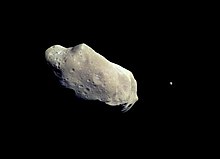Asteroid
![]()
This article is about small planets. For other meanings, see Asteroid (disambiguation).
Asteroids (from ancient Greek ἀστεροειδής asteroeidḗs, German 'sternähnlich'), minor planets, or planetoids are astronomical small bodies that move in Keplerian orbits around the Sun and are larger than meteoroids (millimeters to meters) but smaller than dwarf planets (about a thousand kilometers).
The term asteroid is often used as a synonym of minor planet, but it refers mainly to objects within the orbit of Neptune and is not a term defined by the IAU. Beyond the orbit of Neptune, such bodies are also called trans-Neptunian objects (TNO). According to a more recent definition, the term minor planet subsumes the "classical" asteroids and the TNOs.
To date, 1,060,759 asteroids are known to exist in the solar system (as of February 17, 2021), with several thousand new discoveries added each month and the actual number likely to be in the millions. Asteroids, unlike dwarf planets, by definition have too little mass to come into hydrostatic equilibrium and assume an approximately round shape, and are therefore generally irregularly shaped bodies. Only a few have diameters of more than a few hundred kilometers.
Large asteroids in the asteroid belt are the objects (2) Pallas, (3) Juno, (4) Vesta, (5) Astraea, (6) Hebe, (7) Iris, (10) Hygiea, and (15) Eunomia.

Asteroid (433) Eros, photographed from the NEAR Shoemaker spacecraft

Asteroid (243) Ida with moon Dactyl, photographed from the Galileo spacecraft
Designations
The term asteroid refers to the size of the objects. Asteroid literally means "star-like". Almost all of them are so small that they appear in the telescope like the point of light from a star. The planets, on the other hand, appear as a small disk with some spatial extent.
The term minor planet or planetoid comes from the fact that the objects in the firmament move like planets relative to the stars. Asteroids are not planets and are not considered dwarf planets because their small size means that gravity is too weak to make them anything close to a sphere. Together with comets and meteoroids, asteroids belong to the class of small bodies. Meteoroids are smaller than asteroids, but there is no clear boundary between them and asteroids, either in size or composition.
Dwarf Planets
→ Main article: Dwarf planet
Since the 26th General Assembly of the International Astronomical Union (IAU) and its definition of August 24, 2006, large round objects whose shape is in hydrostatic equilibrium are strictly speaking no longer counted as asteroids, but as dwarf planets.
(1) Ceres (975 km in diameter) is the largest object in the asteroid belt and is the only object counted as a dwarf planet. (2) Pallas and (4) Vesta are large objects in the asteroid belt, but both are not round and therefore by definition not dwarf planets.
In the Kuiper belt, in addition to Pluto (2390 km in diameter) - formerly classified as a planet and now a dwarf planet - there are other dwarf planets: (136199) Eris (2326 km), (136472) Makemake (1430 × 1502 km), (136108) Haumea (elliptical, about 1920 × 1540 × 990 km), (50000) Quaoar (1110 km), and (90482) Orcus (917 km).
The object (90377) Sedna, which was discovered at the end of 2003 beyond the Kuiper belt and has a size of about 995 km, should also be classified as a dwarf planet.
Questions and Answers
Q: What is an asteroid?
A: An asteroid is a small object in the Solar System that travels around the Sun. It is like a planet but smaller and can range from very small (smaller than a car) to 600 miles (1000 km) across.
Q: What does "asteroid" mean?
A: The name "asteroid" means "like a star" in the ancient Greek language. Asteroids may look like small stars in the sky, but they really do move around the Sun, while stars only seem to move because the Earth spins.
Q: Who discovered the first asteroid?
A: Giuseppe Piazzi discovered the first asteroid, in 1801. He called it Ceres, and it is the biggest object in the asteroid belt. Others, like Juno, Pallas, and Vesta were found later.
Q: How are asteroids classified?
A: Depending on what's on their surface, asteroids are classified into various asteroid spectral types including Type M (metal), Type S (stone), and Type C (carbon).
Q: Where are most asteroids located?
A: Most asteroids in our Solar System are located in an area known as the asteroid belt between Mars and Jupiter. However there are also Near-Earth asteroids which come close to Earth's orbit.
Q: What caused some of Earth's extinction events?
A: Many scientists think that asteroids striking Earth killed off all of its dinosaurs and caused some of its other extinction events.
Search within the encyclopedia